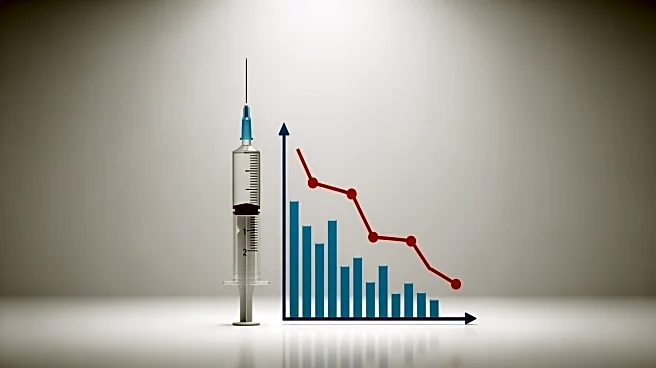What's Happening?
Sanofi's legacy vaccine sales have decreased by nearly 8% in the third quarter, amounting to €3.36 billion ($3.9 billion), as flu and COVID-19 vaccination rates decline in the U.S. The company's flu vaccine sales dropped
by 17% due to increased price competition and lower vaccination rates. Sanofi's CEO, Paul Hudson, noted that the decline was anticipated due to competitive forces and pricing pressures, particularly in Europe. Despite these challenges, Sanofi's Beyfortus vaccine for RSV saw a 20% increase in sales, driven by global rollouts. The company is also in discussions with regulators about a new COVID/flu combo vaccine following positive preliminary results.
Why It's Important?
The decline in vaccine sales highlights the challenges pharmaceutical companies face in maintaining market share amid changing vaccination behaviors and competitive pressures. Sanofi's experience underscores the impact of public health policies and consumer attitudes on vaccine uptake. The company's strategic focus on expanding its RSV vaccine offerings and developing new combination vaccines could help mitigate the impact of declining flu and COVID-19 vaccine sales. This situation also reflects broader trends in the pharmaceutical industry, where companies must adapt to evolving market dynamics and regulatory environments.
What's Next?
Sanofi is expected to continue its efforts to expand the market presence of its RSV vaccine, Beyfortus, and pursue regulatory approval for its COVID/flu combo vaccine. The company may also need to address pricing strategies and competitive pressures to stabilize its vaccine sales. Additionally, public health campaigns and policy changes in the U.S. could influence future vaccination rates, impacting Sanofi's sales performance.
Beyond the Headlines
The decline in flu vaccination rates in the U.S. raises concerns about public health preparedness and the potential for increased flu-related illnesses. Sanofi's strategic initiatives to develop combination vaccines could represent a shift towards more comprehensive immunization solutions, addressing multiple diseases simultaneously. This approach may become increasingly important as healthcare systems seek to improve vaccination coverage and efficiency.












